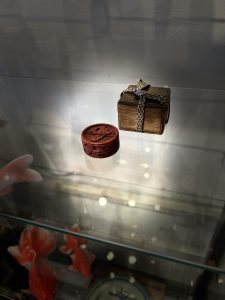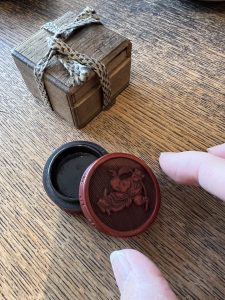遠い記憶の朱色がエモかったです。(愛知県名古屋市千種区姫池通 骨董買取 古美術風光舎)
2023.12.07
みなさまこんにちは、スタッフYでございます。
先日ちょっと買い物にでかけたのですが、クリスマスカラーの赤や緑のオーナメントやディスプレイなどが眼につきます。はたまた赤のセーターをセットアップした店頭などのコーディネートも眼につきますね。こんな自分でさえも、この時期だし、赤いセーター着てみようかな…なんて思えたりするのですから、色彩のアピールはかなり効果があるのでしょうね。
そんな「赤」繋がりではあるのですが、先日から「堆朱」がどうも気になって仕方ありません。
堆朱を眺めていますとどことなくエモいといいますか、懐かしい気持ちになります。過去に堆朱をどこかでみたことがると記憶をたどっていたのですが、そういえば随分に前になくなった祖父の家に堆朱の箱物があったような気がしてきました。いや、あった。たばこで薄汚れた(ヘビースモーカーだった)乱雑な机の上の書き物の傍らに埋まるようにちらっと見えたその「朱」だけがちょっと眼を引いたのでしょうね。
たぶんそんないいものではないですし、彫の図柄の間に埃が纏っていたりしてなにせ普通に使っていたものですから状態も悪かったとは思いますが、幼子Yにとってあの独特な「朱」だけが幼い頃の記憶に残っておりました。そう思いますと、色は遠い記憶に残るくらいのアピールもあるんですね。
幼子Yはそんな「堆朱」のことなど忘れて早、数十年経っておりますがようやっと記憶と結びつけるべく「堆朱」について調べてみました。少しお付き合いください。
漆芸には蒔絵や螺鈿、沈金など様々な技法が存在するのですが、堆朱も漆芸技法の一つ。木地の上に塗り重ねた漆を彫刻刀で彫ってレリーフ状の文様を作る「調漆」のなかでも表面が朱色のものを「堆朱」といい、黒いものは「堆黒」、黄色いものを「堆黄」と呼ぶようです。
調漆の技術が生まれたのは中国の唐代といわれていますが、現存する品から判断すると南宋時代から本格的に制作されていたことがわかっています。中国では朱漆を用いたものを「剔紅」(てきこう)、黒漆を用いたものを「剔黒」(てきこく)と呼ぶらしく、これは日本の堆朱・堆黒に相当するもののようです。
堆朱の技術が日本に伝来したのはなんと平安時代末から鎌倉時代初頃。本格的に堆朱の制作が行われるようになったのは、室町時代頃だといわれておりますが、中国のものと日本のものでは作り方が違うようです。
中国の堆朱は木地の上に何層も漆を塗り重ね、漆の層を乾かしたあとに彫刻を施します。そしてなんと、漆を塗り重ねる回数は300~500回にも及ぶといわれており、まさに気が遠くなるような時間がかかります。このような技法で作られた堆朱の漆芸品は鎌倉や室町時代に盛んに輸入され、「唐物」として珍重されてきました。
一方、日本では塗り重ねた漆を彫刻するのではなく、木地にあらかじめ彫刻を施し、その上に漆を塗るという独自の技法も生まれ、中国の堆朱に比べて使用する漆の量を少なくしながらも、見た目は本来の堆朱に似ていることから広く好まれてきたようです。
祖父の使っていた堆朱の箱物はもちろん日本のものだったとは思いますが、幼子Yの記憶に残った堆朱はきっとヘビースモーカーのニコチンまみれの「朱」だったとは思います笑。それはそれで使い込まれたいい味のでた「朱」になっていたのでしょうが、今はどこにいったのかも知る由もありません。
それにしてもこの「朱」が一気に記憶をも引っ張り出してくれ懐かしい気持ちにさせてくれたり。折角ですので今年は赤いセータでも着てみようかなとも思えてまいりました。
それではごきげんよう。

Hello everyone, this is Staff Y.
The other day, I went shopping for a while, and I noticed red and green ornaments and displays in Christmas colors. I also noticed red sweaters in the stores. Even I, myself, think, “It’s that time of year, I should wear a red sweater…” So, the appeal of color must be quite effective.
In this connection with “red,” I have been thinking about “tsui-shu” since the other day.
When I look at “tsui-shu”, I feel nostalgic. I was trying to trace my memory that I have seen “Tsuishu” somewhere in the past, and I thought that there was a box of “Tsuishu” at my grandfather’s house who passed away a long time ago. No, there was. I guess it was just the “vermillion” that caught my eye, glimpsed as if buried beside the writing on the messy, cigarette-stained (he was a heavy smoker) desk.
It was probably not a very good one, and it was probably in poor condition because it had been used for a long time with dust between the engraved patterns, but for the young Y, only that unique “vermilion” remained in his childhood memory. I think so, the color has such an appeal that it remains in our distant memory.
It has been several decades since I forgot about “tsui-shu,” but I finally looked up “tsui-shu” in order to connect it with my memory. Please bear with me for a moment.
There are various lacquer techniques such as maki-e, raden (mother-of-pearl inlay), and chinkin, and Tsuishu is one of them. In the “sho-urushi” technique, a relief pattern is created by carving a layer of lacquer coated on top of a wooden base with an engraving knife.
It is said that the technique of tonjirushi was born in the Tang dynasty in China, but judging from existing pieces, it is known that full-scale production began in the Southern Song dynasty (960-1279). In China, the term “polychrome” is used for vermilion lacquer, and “polychrome black” for black lacquer, which seems to be the Japanese equivalent of tsui-shu and tsui-kuro.
The technology of tsui-shu was introduced to Japan from the end of the Heian period (794-1185) to the beginning of the Kamakura period (1192-1333). It is said that the production of tsui-shu came into full swing around the Muromachi period (1333-1573), but it seems that the Chinese and Japanese methods of making tsui-shu differ.
Chinese Tsui-shu is made by applying several layers of lacquer on a wooden base, and carving after the layers of lacquer have dried. It is said that the lacquer is applied as many as 300 to 500 times, which is a very time-consuming process. Tsuishu lacquerware made with this technique was actively imported during the Kamakura and Muromachi periods, and was prized as “karamono.
On the other hand, in Japan, a unique technique was developed in which, instead of carving the lacquer over coated lacquer, the wood was carved in advance and the lacquer was applied over the carving.
The Chui-Chu box-shaped item used by my grandfather was of course Japanese, but the Chui-Chu left in my memory as a young child was probably the nicotine-soaked “Chu” of a heavy smoker, lol. I am sure that the “vermilion” left in the memory of young Y was the nicotine-soaked “vermilion” of a heavy smoker, but I have no way of knowing where it has gone.
But still, this “vermilion” brings back memories and makes me feel nostalgic. Since this is a special opportunity, I am thinking of wearing a red sweater this year.
Have a good day.
******************
ご実家の整理やお片付けなどをされている方のご相談などが多くございます。
寒さが厳しい季節となってまいりましたので、お片付けなどくれぐれもご無理のないようになさってくださいませ。
風光舎では古美術品や骨董品の他にも絵画や宝石、趣味のお品など様々なジャンルのものを買受しております。
お片付けをされていて、こういうものでもいいのかしらと迷われているものでも、どうぞお気軽にご相談下さいませ。
また風光舎は、出張買取も強化しております。ご近所はもちろん、愛知県内、岐阜県、三重県その他の県へも出張いたします。
まずは、お電話お待ちしております。
愛知県名古屋市千種区姫池通
骨董 買取
【古美術 風光舎 名古屋店】
TEL052(734)8444
10:00-17:00 OPEN
#出張買取#骨董#古美術#骨董品#絵画#版画#茶道具#刀剣#彫刻


